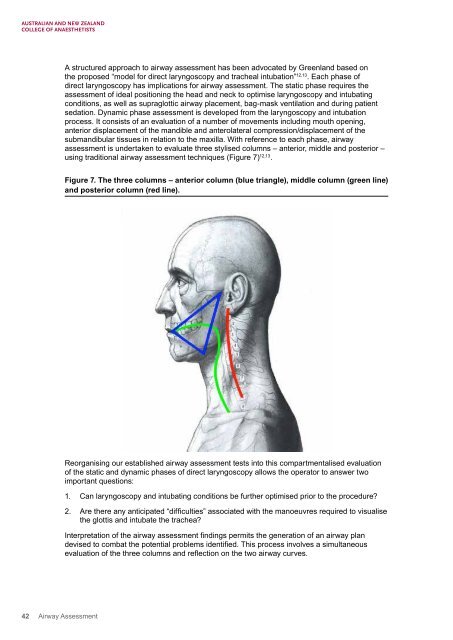Airway Assessment
2cKbSEQ
2cKbSEQ
Create successful ePaper yourself
Turn your PDF publications into a flip-book with our unique Google optimized e-Paper software.
A structured approach to airway assessment has been advocated by Greenland based on<br />
the proposed “model for direct laryngoscopy and tracheal intubation” 12,13 . Each phase of<br />
direct laryngoscopy has implications for airway assessment. The static phase requires the<br />
assessment of ideal positioning the head and neck to optimise laryngoscopy and intubating<br />
conditions, as well as supraglottic airway placement, bag-mask ventilation and during patient<br />
sedation. Dynamic phase assessment is developed from the laryngoscopy and intubation<br />
process. It consists of an evaluation of a number of movements including mouth opening,<br />
anterior displacement of the mandible and anterolateral compression/displacement of the<br />
submandibular tissues in relation to the maxilla. With reference to each phase, airway<br />
assessment is undertaken to evaluate three stylised columns – anterior, middle and posterior –<br />
using traditional airway assessment techniques (Figure 7) 12,13 .<br />
Figure 7. The three columns – anterior column (blue triangle), middle column (green line)<br />
and posterior column (red line).<br />
Reorganising our established airway assessment tests into this compartmentalised evaluation<br />
of the static and dynamic phases of direct laryngoscopy allows the operator to answer two<br />
important questions:<br />
1. Can laryngoscopy and intubating conditions be further optimised prior to the procedure?<br />
2. Are there any anticipated “difficulties” associated with the manoeuvres required to visualise<br />
the glottis and intubate the trachea?<br />
Interpretation of the airway assessment findings permits the generation of an airway plan<br />
devised to combat the potential problems identified. This process involves a simultaneous<br />
evaluation of the three columns and reflection on the two airway curves.<br />
42 <strong>Airway</strong> <strong>Assessment</strong>


